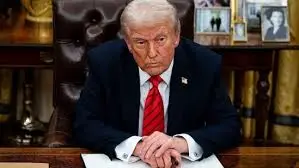The pause on tariffs, and now a stay: where does this leave Trump’s disruptive trade agenda

WASHINGTON — A Pivotal Moment for U.S. Trade Policy
The Trump-era trade agenda—defined by its aggressive tariff strategy and “America First” economic nationalism—is at a critical inflection point. With recent decisions to pause the imposition of new tariffs and a judicial or administrative stay halting others, the legacy and future of former President Donald Trump’s trade disruption campaign are now in limbo.
This double move—the pause in implementation and the stay on enforcement—raises questions about the durability of Trump’s approach in the face of legal pushback, shifting political winds, and the economic realities of global trade.
Backdrop: A Disruptive Trade Doctrine
Donald Trump’s presidency ushered in the most aggressive shift in U.S. trade policy since the post-World War II era. Under slogans like “Tariff Man” and “Bring Jobs Back,” his administration levied sweeping tariffs on China, steel and aluminum imports, and other foreign goods, often invoking national security or unfair competition.
The strategy divided economists and policymakers. Supporters credited it with confronting China’s trade practices and revitalizing some domestic industries. Critics argued it distorted markets, raised consumer costs, and weakened global alliances.
Recent Moves: The Pause and the Stay
Two developments this month have triggered a reassessment of that agenda:
- The Biden administration’s quiet pause on new tariff actions—including potential penalties against Chinese electric vehicles and semiconductors—signals a more cautious approach ahead of the 2025 election season.
- A federal court ruling temporarily staying a set of Section 301 tariffs—originally imposed by the Trump administration and continued under Biden—citing procedural missteps and lack of sufficient justification. The case, brought by U.S. importers, argues that the Office of the U.S. Trade Representative overstepped its legal bounds.
Together, these moves slow the momentum of Trump-style trade policy, at least for now.
Political Calculations and Legal Barriers
The pause appears partly strategic. With inflation still a concern, and American businesses urging stability in supply chains, President Biden may be seeking to avoid policy shocks before the 2025 presidential election. The administration has emphasized a “worker-centered” trade policy, but it has so far stopped short of launching new protectionist measures of its own.
Meanwhile, the court-ordered stay highlights a growing judicial skepticism toward executive overreach in trade matters. Legal experts note that past administrations, including Trump’s, stretched trade statutes to justify sweeping tariffs—moves that are now being challenged under administrative law.
Business Community Response
Corporate leaders, particularly in the retail and manufacturing sectors, have welcomed the pause and stay. Groups like the National Retail Federation and the U.S. Chamber of Commerce have long criticized the unpredictability of tariff swings, arguing they disrupt planning and raise prices for consumers.
“While we support strong action on unfair trade, businesses need clear rules and legal consistency,” said Jennifer Safavian, CEO of Autos Drive America, a trade group representing foreign automakers with U.S. factories.
Still, some domestic producers who benefited from tariff protection—such as U.S. steelmakers and legacy manufacturers—are voicing concern about a possible softening of trade defenses.
What This Means for Trump’s Legacy and 2025 Campaign
Donald Trump, now the presumptive Republican nominee for the 2025 presidential election, has doubled down on his trade agenda on the campaign trail. He has proposed a universal 10% tariff on all imports, labeled opponents as “globalists,” and positioned tariffs as a tool to restore industrial America.
The recent legal and administrative setbacks may limit his ability to immediately revive such policies if reelected. But his rhetoric continues to resonate with key parts of the electorate—particularly in swing states reliant on manufacturing jobs.
“The trade war isn’t over—it’s just paused,” said a senior Trump campaign advisor. “A second Trump term will bring the full reset.”
Outlook: Trade Policy at a Crossroads
While the current moves do not amount to a full-scale rollback, they symbolize a moment of strategic uncertainty. The future of U.S. trade policy will likely hinge on three key factors:
- Legal challenges and court decisions that could constrain executive flexibility.
- Election outcomes in 2025, which could determine whether the U.S. resumes aggressive tariff tactics or pursues a more multilateral, rules-based trade strategy.
- Global economic pressures, including tensions with China, reshoring efforts, and inflation dynamics.
For now, the Trump trade agenda is on hold—but not dismantled. Whether it returns in force or fades into history depends on how the next chapter in Washington unfolds.






